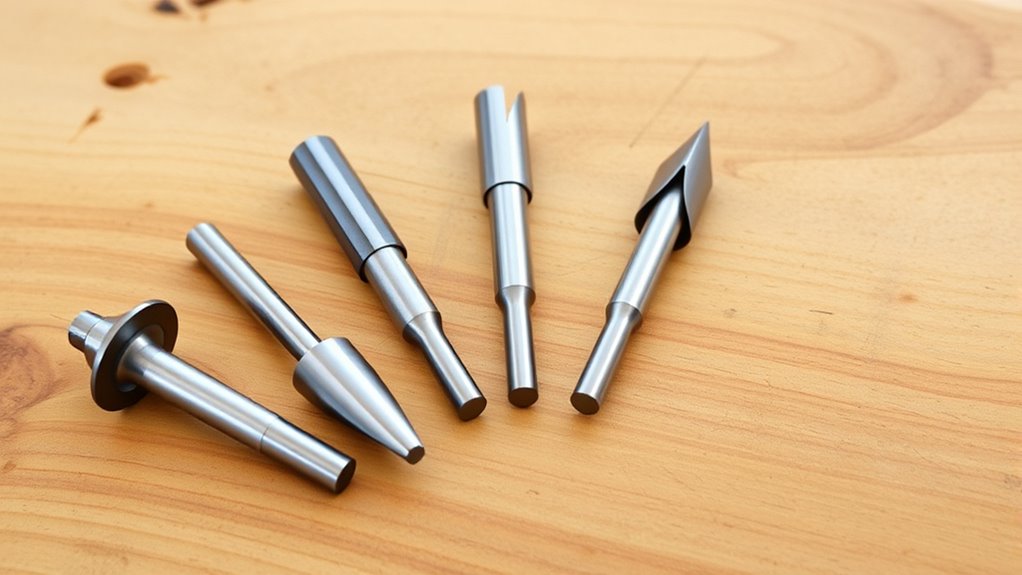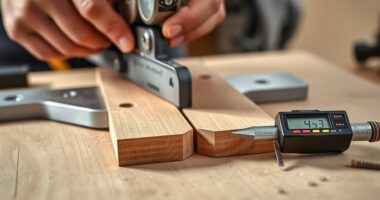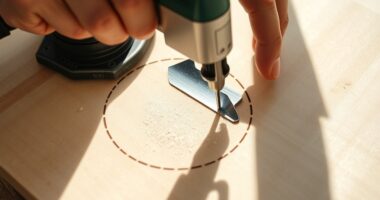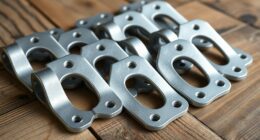To elevate your woodworking projects, you should own five key router bit profiles: straight bits for precise cuts and joinery, ogee and rounded bits for decorative edges, ornate profiles like Roman ogee for intricate details, beveled bits for sleek angled edges, and chamfer bits for clean bevels. Each of these expands your creative options and helps you achieve professional results. Keep going to discover how these profiles can transform your woodworking skills.
Key Takeaways
- Straight bits are essential for precise cuts, grooves, and flat edge treatments, forming a versatile foundation for many projects.
- Ogee and rounded profile bits soften edges and add decorative elegance to tabletops, moldings, and furniture.
- Decorative and intricate profile bits enable detailed inlays and ornate edges, enhancing visual appeal without complex carving.
- Beveled and chamfer bits create sleek, angled edges for modern designs and polished finishing touches.
- Having a variety of profiles expands creative possibilities, allowing for detailed accents, decorative patterns, and professional results.

Router bit profiles determine the shape and finish of your cuts, making them essential tools for woodworking projects. Whether you’re aiming for smooth edge treatments or intricate decorative inlays, selecting the right router bits can markedly elevate your work. Each profile offers a unique cut, allowing you to add detailed accents, refine edges, or create decorative patterns that bring your projects to life. Having a versatile set of router bit profiles ensures you’re prepared for a wide range of design possibilities and helps you achieve professional-quality results with ease.
One of the most fundamental profiles to own is the straight bit. It’s perfect for making clean, precise cuts, grooves, and dados. You’ll use it often for edge treatments that require a flat, smooth finish or for creating channels to insert decorative inlays. Straight bits are versatile and serve as the backbone for many projects, whether you’re trimming edges or preparing material for jointing. They’re also indispensable for hollowing out areas or removing material quickly and accurately. Pairing a straight bit with smaller, specialty bits expands your capabilities, especially when working on detailed inlays or complex joinery.
Another vital profile is the round-over or ogee bit. This bit shapes edges into rounded profiles, softening sharp corners for a more finished look. It’s excellent for creating decorative edge treatments on tabletops, cabinet doors, or moldings. The rounded profile adds a subtle elegance that enhances the overall aesthetic of your projects. When doing decorative inlays, the ogee bit can help create smooth, flowing edges that frame the inlay work beautifully, making the details stand out. Additionally, understanding router bit profiles can help you select the right tools for achieving consistent, high-quality results.
The core of many decorative projects lies in the decorative bit, such as a Roman ogee or a cove bit. These bits allow you to craft intricate profiles that add character and depth to your work. They’re especially useful when designing decorative edges or adding ornate details to furniture pieces. With these profiles, you can achieve a professional, handcrafted look without needing advanced carving skills. They also work well for creating decorative inlays, where the profile’s shape complements the contrasting materials or colors used.
Lastly, a beveled or chamfer bit is a must-have for creating angled edge treatments. It’s perfect for adding a sleek, modern touch to edges or for beveling corners before finishing. Chamfer bits help you produce clean, consistent angles that improve the visual appeal and safety of your projects. They’re often used in combination with other bits to frame inlays or decorative accents, giving your work a polished, finished look.
Frequently Asked Questions
How Do I Choose the Right Router Bit for My Project?
When choosing the right router bit for your project, consider the type of cut you need and the material you’re working with. Pay attention to router bit materials like high-speed steel or carbide, as they affect durability and cutting performance. Also, check bit compatibility considerations, ensuring the shank size matches your router. Selecting the right bit helps you achieve clean cuts and prolongs your tool’s lifespan.
What Safety Precautions Should I Take When Using Router Bits?
Think of safety as your shield in the woodworking arena. Always wear personal protective equipment like goggles and ear protection to guard against flying debris and noise. Follow safe operating procedures by securing your workpiece and maintaining a firm grip. Keep your hands clear of the bit’s path, and never force the tool. These precautions turn your workspace into a fortress, ensuring you carve with confidence and safety every time.
How Do I Maintain and Sharpen My Router Bits?
To keep your router bits in top shape, you should regularly perform bit sharpening and router bit cleaning. Use a fine diamond or carbide grit stone for sharpening, making sure you maintain the proper bevel angle. For cleaning, soak the bits in a degreasing solution or use a wire brush to remove pitch and resin buildup. Proper maintenance extends your bits’ lifespan and ensures cleaner, safer cuts every time you use your router.
Can I Use These Router Bits With Any Router Model?
You wonder if these router bits fit any router model, but the truth is, not all are universal router bits. While some offer broad router bit compatibility, many are designed for specific brands or shank sizes. Always check your router’s specifications before buying. Using incompatible bits can lead to poor cuts or safety hazards. So, choose your bits carefully, ensuring they match your router’s model and shank size for peak performance.
What Materials Are Best Suited for Each Router Bit Profile?
When choosing router bits, consider your project’s material compatibility and hardness. High-speed steel bits work well with softer woods like pine, while carbide-tipped bits are better for harder woods such as oak or maple. Always match the bit profile to the desired cut, ensuring it’s suitable for the material’s hardness. This way, you get clean cuts and prolong your bits’ lifespan, making your woodworking more efficient and precise.
Conclusion
Think of these router bit profiles as the paintbrushes in your woodworking toolkit. With each one, you add a new color to your creative palette, transforming plain wood into stunning pieces. Mastering these profiles unlocks endless design possibilities, turning simple projects into works of art. Embrace these bits like trusted tools in your hands, and watch your craftsmanship flourish—your woodworking journey is a blank canvas waiting for your signature touch.









